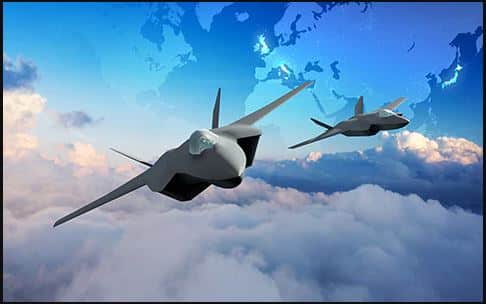Aerospace
UK industry to play key role in new Global Combat Air Programme

The UK’s sovereign industry partners, under Team Tempest, will support the significant endeavour announced today by the Governments of the UK, Japan and Italy, which will see the three nations build a truly international programme, with a shared ambition to develop a next generation fighter aircraft under a new Global Combat Air Programme (GCAP).
The joint announcement, highlights the close government, military and industrial links between the nations and reinforces the UK’s international commitment to future combat air. The programme will build on the substantial progress already made in the UK by BAE Systems, Leonardo UK, MBDA UK, Rolls-Royce and the UK Ministry of Defence who have been working in partnership since 2018 as Team Tempest to research, evaluate and develop a host of next generation future combat air systems capabilities.
The UK’s combat air industry not only supports national defence and security, but the £6bn-a-year sector also delivers substantial economic and social value. The GCAP could secure or create thousands of UK jobs while keeping irreplaceable combat air engineering skills onshore for another generation. A report published last year by analysts at PricewaterhouseCoopers (PwC) concluded that should the UK take a core role in a next generation fighter jet programme, it could expect to support an average of 21,000 jobs a year and contribution an estimated £26.2bn to the economy by 2050.
In the UK, around 2,500 people are already working on the programme as part of Team Tempest and wider industry. Beyond the Team Tempest partners, more than 580 organisations are already on contract across the UK, including 91 SMEs and 26 academic institutions. The Team Tempest partners have recruited more than 1,000 apprentices and graduates since the launch of the project in 2018, with young people nationwide inspired by the opportunity to be part of a once-in-a-generation combat air programme.
Qantas and Airbus Partnership for the biofuel industry.(Opens in a new browser tab)
The UK industry partners have already generated strong working relationships with their counterparts in Italy and Japan, which will progress into the new joint development. These include IHI Corporation, Mitsubishi Electric and Mitsubishi Heavy Industries in Japan, and Avio Aero, Elettronica and Leonardo in Italy.
It is expected that GCAP will generate long-term technological, industrial and social benefits for the three partner countries and inspire the next generation of engineering talent.

Aerospace
When Ratan Tata was denied entry to the airfield at the Aero India show, he waited

During our visit to Aero India 2019, we had the unexpected opportunity to see Ratan Tata at the event, which was a thrilling moment for us. However, there was a surprising hiccup when the security staff didn’t allow him to enter due to a lack of a security pass.
Despite this, he remained calm and patiently waited for about 20 minutes until a member of the Tata team brought him the required pass, after which he calmly proceeded inside. It was a humbling sight, showcasing his composed demeanor even in such situations.
Ratan Tata ji is not only a renowned industrialist but also a trained pilot, holding a pilot’s license. In 2007, he became the first Indian civilian to fly the F-16 Falcon during the Aero India show in Bangalore—a proud moment for the nation.
His passion for aviation extended beyond flying, as he played a key role in shaping India’s aerospace industry. Under his leadership, Tata ventured into manufacturing and maintaining aerospace components while upholding its legacy of quality. Notably, Tata’s collaboration with Airbus to develop and manufacture the C295 aircraft is a testament to its growing influence in the sector.
-

 Aviation2 months ago
Aviation2 months agoMicrosoft Flight Simulator Raises $3 Million to Bring Back the An-225 Mriya
-

 Airlines2 months ago
Airlines2 months agoQatar Citizens Can Travel to the United States Without a Visa
-

 Aviation2 months ago
Aviation2 months agoQatar Airways bans these new Electronic Devices on plane
-

 Airlines2 months ago
Airlines2 months agoJapan Airlines Rolls Out Free Domestic Flights to International Passengers
-

 Travel2 months ago
Travel2 months agoQatar Airways Launches Four Additional Flights from Amsterdam
-

 Defence2 months ago
Defence2 months agoWhich Country Has the Largest Fleet of Fighter Aircraft?
-

 Airport2 months ago
Airport2 months agoWestern Sydney Airport Welcomes Its First Plane After 6 Years of construction
-

 Airlines4 days ago
Airlines4 days agoDAMAC Air: Dubai’s New Luxury Airline Offers Free Flights for Registration








